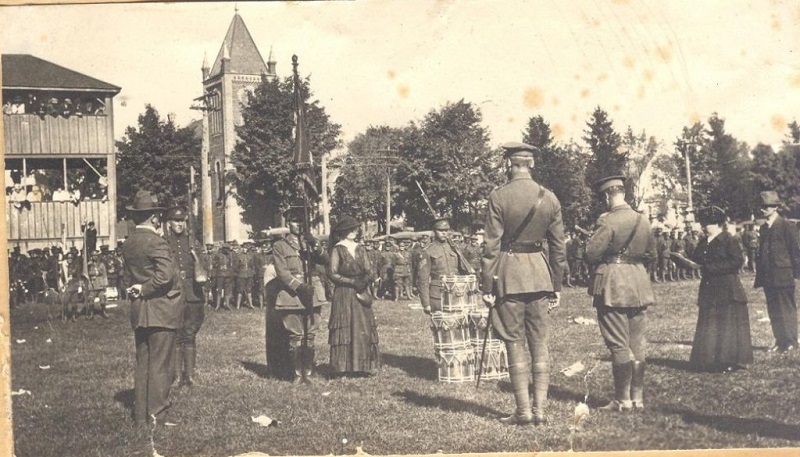Private Jacob Isaac of the Six Nations Reserve 739554 was born on 3 December 1893. He was the son of Silas and Lucy Isaac, Ohsweken, Tuscarora Township, Ontario. Jacob enlisted on 29 November 1915, with the 114th (Haldimand) Battalion. Also known as “Brock’s Rangers.” Recruited in Haldimand County, and on the Six Nations Reserve.
Almost 300 Indigenous warriors joined the battalion. In ‘D’ Company, the majority were from Ohsweken. The brass, and bugle band composed of Indian musicians. Haldimand County had more men in training, in Canada and overseas, than any other county in Ontario.
The 37th Haldimand Rifles name changed to the 114th Battalion CEF, in December 1915. Later, perpetuated by The Haldimand Rifles. In 1936, amalgamated with The Dufferin Rifles. Finally, forming The Dufferin and Haldimand Rifles of Canada.

Back Row: 3rd from left – Alex Mowat
2nd Row: 1st from left – Wilf MacDonald
3rd from right – Erin Smith
Front Row: 1st from left – Charlie Hughes
1st on right – Earl Fissette
Jacob stood 6 feet tall. The RSM noting dark “Indian” complexion, dark brown eyes, and black hair. He was Methodist. Jacob Isaac of the Six Nations Reserve has three years prior service, with the 37th Haldimand Rifles.

Service
Private Jacob Isaac arrived in England aboard S.S. CARONIA, on 11 November 1916. S.S. CARONIA was the ship which warned R.M.S. TITANIC of ice flows on 14 April 1912.

Also on 11 November, the 114th Battalion absorbed by 35th and 36th Canadian Reserve Battalion. Then, Jacob is Taken-on-Strength, 35th Battalion, West Sandling, 20 November 1916.
Shortly afterwards, Jacob tried for an offense committed on 30 November 1916. Conduct to the prejudice of good Order & Military Discipline, 1 December 1916 at West Sandling. Jacob found guilty. And, sentenced to 10 Days of Field Punishment No. 2.
Field Punishment Number 1 consisted of the convicted man being shackled in irons and secured to a fixed object. Often a gun wheel, or similar object chosen. He could only be thus fixed for up to 2 hours in 24. And, not for more than 3 days in 4. Or, for more than 21 days in his sentence. This punishment often known as crucifixion. And, due to its humiliating nature, viewed by many as unfair.

Field Punishment Number 2 similar, except the man shackled, but not fixed to anything. Both forms carried out by the office of the Provost-Marshal, unless his unit was officially on the move. Then, carried out regimentally. That is, by his own unit.
After completing his sentence, Jacob taken on by the 4th Reserve Battalion. However, Jacob soon admits himself to Canadian Hospital Etchinghill, with V.D.G., 5 January 1917. His rehabilitation is slow, and he discharges on 9 March 1917.
First voyage overseas
Proceeded overseas to 1st Battalion, from Bramshott Camp, 17 May 1917. In September 1917, Jacob sees action in the Battle of Hill 70.
In the St. Laurent sector, while acting with a covering party for wirers, Jacob is sniped. Admitted to No.22 C.C.S., GSW right thigh, 20 September 1917. Then, admitted No.26 General Hospital, Etaples, GSW right thigh, 21 September 1917. Jacob is invalided back to England.
Admitted 2nd West General Hospital, Manchester, 26 September 1917. Finally, admitted to Canadian General Hospital Epsom, GSW right thigh, 6 November 1917.
Jacob’s recovery has been compounded by shell shock. He is finally, discharged, 28 November 1917. Again, posted to 4th Reserve Battalion, 28 November 1917.
Jacob is given more time to get his fighting spirit back. Then, in preparation for traveling overseas, Jacob is S.o.S. to 1st Battalion, at Witley Camp, 1 June 1918. He will soon be back on the Western Front
Second voyage overseas
Jacob rejoins unit in the field, 24 August 1918. He arrives just in time for the Battle of the Scarpe. Now the 1st Battalion is at full strength. Earlier in the month, they saw limited action in the Battle of Amiens, and relieved the 3rd Canadian Division in the line on 16 August 1918.
On 30 August 1918, the 1st Battalion reaches it’s objectives after a powerful opening barrage. However, many men are claimed by heavy enemy machine-gun fire. While taking part the attack near Upton Wood, North of Hendecourt-lez-Cagnicourt, Jacob is hit in the heart by an enemy bullet – death being instantaneous.
The 1st Battalion losses are heavy, with many falling to machine-gun fire. During the morning, sixty men are killed. Later in the day, forty-two, including Jacob are immediately buried in a new battlefield cemetery.

Upton Wood Cemetery
The Upton Wood Cemetery contains 53 men of the 1st Battalion from ‘A’, ‘B’ and ‘D’ Companies. Note, one company is always held in reserve during battle. Should the battalion be decimated in battle, the surviving company is used to help train reinforcements. Then, the unit is ready to return to battle readiness.

Jacob Isaac of the Six Nations Reserve is the first man of the 1st Battalion to be buried in Upton Wood Cemetery. He lies in Row A, Grave 2. Like Sucrerie Cemetery in Ablain-St. Nazaire, many of the headstones in Upton date to the early 1920’s.
It is difficult to obtain a good photo when the engravings as so worn. Discouraged at sunset on the previous night, returned the following morning. Alas, disappointed once again. A return is in the works. When air-travel is safe again. We Remember Them.
More
Please subscribe to CEFRG to be notified by email when there are new posts. Subscription is free, and your email kept confidential.

Comments
One response to “Private Jacob Isaac in the Great War”
[…] fire. While taking part the attack near Upton Wood, North of Hendecourt-lez-Cagnicourt, Private Jacob Isaac, 1st Battalion is killed. Jacob was from the Six Nations Reserve. He was hit in the heart by an […]